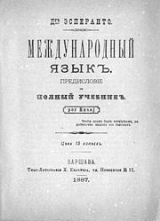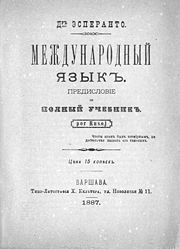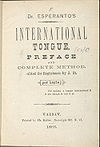
Unua Libro
Encyclopedia


Esperanto
is the most widely spoken constructed international auxiliary language. Its name derives from Doktoro Esperanto , the pseudonym under which L. L. Zamenhof published the first book detailing Esperanto, the Unua Libro, in 1887...
(then called Lingvo Internacia, "international language"). It was first published in Russian
Russian language
Russian is a Slavic language used primarily in Russia, Belarus, Uzbekistan, Kazakhstan, Tajikistan and Kyrgyzstan. It is an unofficial but widely spoken language in Ukraine, Moldova, Latvia, Turkmenistan and Estonia and, to a lesser extent, the other countries that were once constituent republics...
on July 26, 1887 in Warsaw
Warsaw
Warsaw is the capital and largest city of Poland. It is located on the Vistula River, roughly from the Baltic Sea and from the Carpathian Mountains. Its population in 2010 was estimated at 1,716,855 residents with a greater metropolitan area of 2,631,902 residents, making Warsaw the 10th most...
, by Dr. L.L. Zamenhof
L. L. Zamenhof
Ludwig Lazarus Zamenhof December 15, 1859 – April 14, 1917) was the inventor of Esperanto, the most successful constructed language designed for international communication.-Cultural background:...
, the creator of Esperanto. Over the next few years editions were published in Russian
Russian language
Russian is a Slavic language used primarily in Russia, Belarus, Uzbekistan, Kazakhstan, Tajikistan and Kyrgyzstan. It is an unofficial but widely spoken language in Ukraine, Moldova, Latvia, Turkmenistan and Estonia and, to a lesser extent, the other countries that were once constituent republics...
, Hebrew
Hebrew language
Hebrew is a Semitic language of the Afroasiatic language family. Culturally, is it considered by Jews and other religious groups as the language of the Jewish people, though other Jewish languages had originated among diaspora Jews, and the Hebrew language is also used by non-Jewish groups, such...
, Polish
Polish language
Polish is a language of the Lechitic subgroup of West Slavic languages, used throughout Poland and by Polish minorities in other countries...
, French
French language
French is a Romance language spoken as a first language in France, the Romandy region in Switzerland, Wallonia and Brussels in Belgium, Monaco, the regions of Quebec and Acadia in Canada, and by various communities elsewhere. Second-language speakers of French are distributed throughout many parts...
, German
German language
German is a West Germanic language, related to and classified alongside English and Dutch. With an estimated 90 – 98 million native speakers, German is one of the world's major languages and is the most widely-spoken first language in the European Union....
, and English
English language
English is a West Germanic language that arose in the Anglo-Saxon kingdoms of England and spread into what was to become south-east Scotland under the influence of the Anglian medieval kingdom of Northumbria...
. This booklet included the Lord's Prayer
Lord's Prayer
The Lord's Prayer is a central prayer in Christianity. In the New Testament of the Christian Bible, it appears in two forms: in the Gospel of Matthew as part of the discourse on ostentation in the Sermon on the Mount, and in the Gospel of Luke, which records Jesus being approached by "one of his...
, some Bible
Bible
The Bible refers to any one of the collections of the primary religious texts of Judaism and Christianity. There is no common version of the Bible, as the individual books , their contents and their order vary among denominations...
verses, a letter, poetry
Poetry
Poetry is a form of literary art in which language is used for its aesthetic and evocative qualities in addition to, or in lieu of, its apparent meaning...
, the sixteen rules of grammar and 900 roots of vocabulary. Zamenhof declared, "an international language, like a national one, is common property
Public domain
Works are in the public domain if the intellectual property rights have expired, if the intellectual property rights are forfeited, or if they are not covered by intellectual property rights at all...
." Zamenhof signed the work as "Doktoro Esperanto" and the title Esperanto stuck as the name of the language which, in Esperanto, means "one who is hoping".
The first English edition, entitled "Dr Esperanto's International Tongue", was translated by Julian Steinhaus. When Richard H. Geoghegan
Richard H. Geoghegan
Richard Henry Geoghegan was an Englishman of Irish descent. As a young man he lived for a while in Washington State and then moved to Alaska...
pointed out that Steinhaus's translation was in very poor English throughout, Zamenhof destroyed his remaining copies and engaged Geoghegan to produce a fresh translation.
In 1905, Zamenhof re-published the sixteen rules of grammar, in combination with a "universal dictionary" and a collection of exercises, in a work entitled Fundamento de Esperanto
Fundamento de Esperanto
The Fundamento de Esperanto is a book by L. L. Zamenhof, published in the spring of 1905. On August 9, 1905 it was made the official source for the language by the fourth article of the Declaration of Boulogne at the first World Congress of Esperanto in Boulogne-sur-Mer, France:It is considered...
("Foundation of Esperanto").
External links
• Online HTML reprint of Dr. Esperanto's International Language: Introduction and Complete Grammar (English translation of "Unua Libro" by R. H. Geoghegan, 1889) http://www.genekeyes.com/Dr_Esperanto.html• LibriVox free audiobook of Dr. Esperanto's International Language: Introduction and Complete Grammar (English translation of "Unua Libro" by R. H. Geoghegan, 1889), mp3 or ogg files, read by Nicholas James Bridgewater http://librivox.org/dr-esperantos-international-language-introduction-and-complete-grammar-by-ll-zamenhof/
These reprints of the Unua Libro have no ISBN.
 Meždunarodnyj jazyk: Predislovie i polnyj učebnik Moscow: Moskva Gazeto, 1992. Facsimile reprint of the Unua Libro in Russian.
Meždunarodnyj jazyk: Predislovie i polnyj učebnik Moscow: Moskva Gazeto, 1992. Facsimile reprint of the Unua Libro in Russian. Ludovikologia dokumentaro I Tokyo: Ludovikito, 1991. Facsimile reprints of the Unua Libro in Russian, Polish, French, German, English and Swedish, with the earliest Esperanto dictionaries for those languages.
Ludovikologia dokumentaro I Tokyo: Ludovikito, 1991. Facsimile reprints of the Unua Libro in Russian, Polish, French, German, English and Swedish, with the earliest Esperanto dictionaries for those languages.

